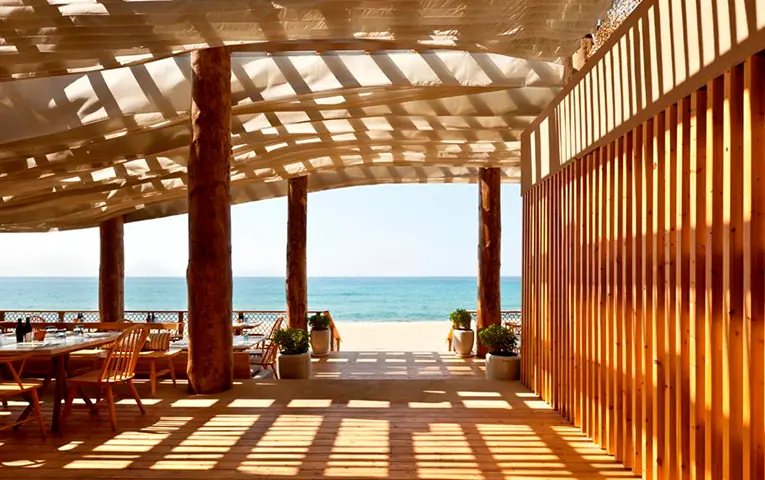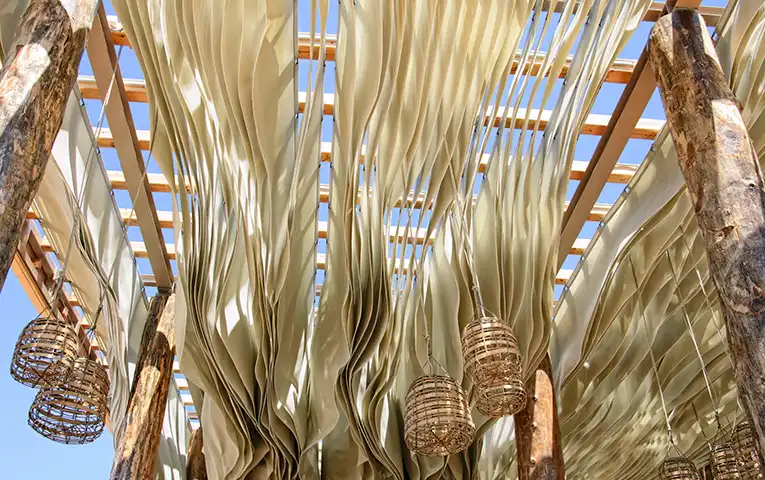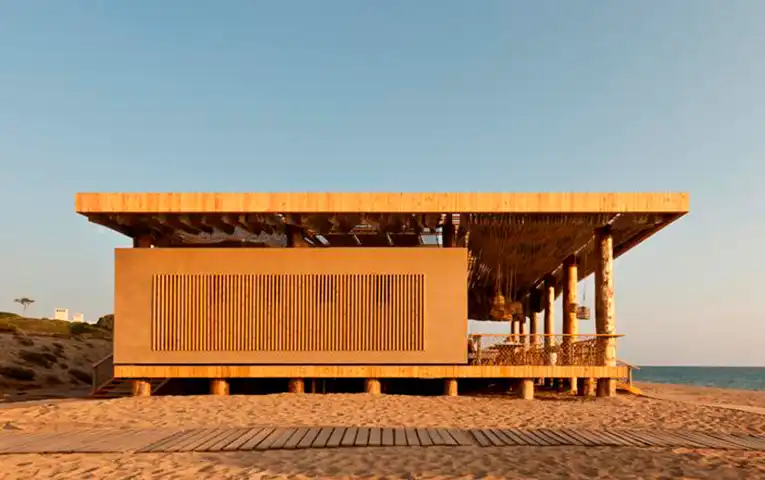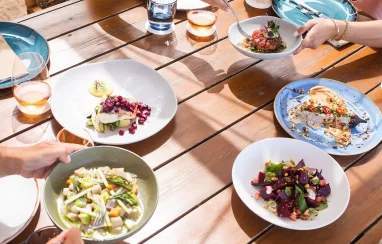By Paulina Björk Kapsalis
The Dunes Beach at Costa Navarino is over a kilometer long, with the type of deep, pillowy sand your feet sink into, and endless space for ambitious castle building and watersport activities. When there’s wind – and there is some on most days – the waves roll in magnificently, either smooth and surging or spilling and plunging into the sand, with the white crests lacing the shoreline as far as the eye can see. It’s one of those pristine settings that makes you feel like you’re one with nature.
From afar and from the sea, it’s hard to spot. Built from natural wooden columns that resemble driftwood, rope netting, and walls made with sand like a life-size contemporary version of a sandcastle, Barbouni blends into its environment in a way that feels natural but is in fact very obviously intentional – when you look closely. And although millions of people know it only from the viral images on their screens, it definitely does deserve an up-close look. Besides the famous canopy ceiling that sways hypnotizingly above diners’ heads, the modern and sustainable structure is a treat for any architecture buff; a great example of a site-specific design that the architects refer to as “multi-sensory.”

On my first visit to Barbouni, I sat for a long time at the table, determined to memorize everything: the susurration of the waves, the aroma of the wine and taste of the food (grilled octopus with fava bean puree, cured anchovies and fresh cheese on sourdough bread, seabass with beetroot caper salsa), the beauty of the moving ceiling, and the warmth of the sun filtering through it. As it turns out, the only mnemonic device needed to remember Barbouni is one keyword that connects it all: Messinia.
“We always do a deep analysis of the conditions at the locations where we are invited to design,” says Konstantinos Karampatakis, who runs Athens-based K-Studio with his brother, Dimitris Karampatakis. “When we were invited to Costa Navarino to pitch this project back in 2010, we could immediately sense the founders’ honest love for this site, and while a question they were struggling with was ‘How can we block the wind and keep the view?’ we approached it differently.” Studying the location, wind seemed to the architects an inextricable part of the landscape, and one of the most attractive parts of the destination. A soft wind is what makes visits to the beach on hot summer days pleasurable, so why block it? Instead, they decided to highlight it by making it visible.

The story of the moving canopy ceiling began in the studio, where the first simulations involved stringing sheets of paper across the room and opening the windows, but the actual result only materialized once on site, where they finally got to see the magical wave-like ripples created by the Messinian wind. It resembles the movement of the sea, and that of the grass growing on the dunes. Besides its aesthetic value, it also filters the sunlight just enough, and there were other thoughts behind it too; the use of fabric, Konstantinos explains, seemed natural for the location at Costa Navarino, reflecting the coziness of the linen at the resorts. Plus, as he puts it, “No one wants to be the first person in a space – unless there’s movement. Here, the building is the first character present.”
London photographer Nige Levanterman (@levanterman) caught the first footage of the canopy that went viral. His cinemagraph, a static photo where only the ceiling moves on a three-second loop, gained millions of views and comments from all over the world on both Instagram and Facebook. Many questioned whether it was real or simply computer generated. “The mystery made it go viral,” he says, “but it’s actually real, and much better in real life! The location was perfect for a cinemagraph.”
View this post on Instagram
Other commenters often wonder whether the imposing presence of the canopy is distracting or annoying while you eat, but on the contrary, it appears to have a remarkably soothing effect on most of us. Levanterman refers to it as mesmerizing, therapeutic, and relaxing: “I think even the noise it makes, the flapping sound of the material in the wind, is perfect.”
Travel blogger Marta Heine-Geldern, more famous as @voyage_provocateur, who visited friends at one of the Costa Navarino residences last summer, agrees: “It is soothing. At some point you drift off into your own thoughts… Very often one sees a place become famous on the internet, and is then disappointed by the reality. In case of Barbouni, the actual experience of the restaurant was better than what I expected.”
View this post on Instagram
As with the rest of Costa Navarino, sustainability was a key factor for every design choice at Barbouni. Natural and local materials were used, and the entire structure is naturally cooled down, with 30-centimeter-thick walls keeping the heat out of the kitchen. Using materials with minimal need for maintenance was another important decision. The wood, rope, and river sand in the building blocks are at once heavy-duty, and have a naturally weathered appearance. “The first thing we had to think of was doing minimum impact on the shore,” says Konstantinos, “and it was hard, because when you excavate in a sandy ground you end up having a more specific foundation – we wanted the structure to hardly touch the ground.”

The last thing on their mind, on the other hand, was going viral. “We’re thankful to Nige Levanterman for capturing it so beautifully,” says Konstantinos, and laughs recalling some of the reactions they’ve gotten since: “Friends often tell us ‘Oh, we went to Barbouni, but it wasn’t windy’ – as if no wind is a bad thing! That’s when we know that, wow, this is really successful.”
“There was no Instagram then. It was more about living the moment than Instagram moments,” Dimitris Karampatakis adds. “I think it’s great to see how an actual emotional and physical experience lends itself to also be a feature – an attraction. There’s substance to it – it’s not just a superficial image, but rather the image presents the true feeling of being there, in a really special place.”

